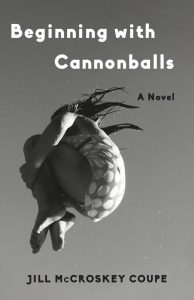Five Books by Women Writers I’ve Read More Than Once And Why
 By Jill McCroskey Coupe, author of BEGINNING WITH CANNONBALLS
By Jill McCroskey Coupe, author of BEGINNING WITH CANNONBALLS
- Psyche: The Feminine Poetic Consciousness, An Anthology of Modern American Women Poets, edited by Barbara Segnitz and Carol Rainey. Dell Publishing Co., 1973.
During my first bumbling attempts at creative writing, I devoured this book. I underlined important sections in the Introduction and marked passages in poems that spoke to my soul. Now, decades later, I realize I was wrong in some of my interpretations. Still, this book marks the beginning of my writing life.
At first, I attempted to write poetry. I then switched to short stories. It took me years to realize that I’m more comfortable in the longer forms. I now think of myself as a novelist.
- Loitering with Intent, by Muriel Spark. Coward, McCann & Geoghegan, 1981.
Whenever I’m asked who my favorite author is, I reply, “Muriel Spark.” Sometimes this elicits a blank look, and I add, “You know, she wrote The Prime of Miss Jean Brodie, which was made into a movie starring Maggie Smith.” If the blank look is still there, I give up. I don’t go on to say that I’ve read all of Muriel Spark’s novels at least once. I don’t offer the advice that Loitering with Intent–in addition to being a wonderfully wry, ironic novel about the sometimes slippery interplay between life and art–offers excellent advice about how to write a novel.
Pay close attention to everyone you meet, Ms. Spark was saying. Register every detail. Then feel free to use whatever you can.
- Tumble Home, by Amy Hempel. Scribner, 1997.
For a time, while volunteering at an adult literacy program, I tutored a woman who’d dropped out of school after sixth grade. Having recently retired from her janitorial job, she’d decided to use some of her free time to improve her reading skills.
Ruby and I had been meeting once a week, for about a year, when I decided to share my love of fiction with her. I brought my copy of Tumble Home to our next session, in part because the first story in this collection is only two pages long. Ruby read “Weekend” out loud, flawlessly. Then she turned the page. For more than an hour, long past the time for our session to be over, she read Amy Hempel’s stories to me. At home that night, I reread the rest of the stories myself, admiring them in a completely new way.
A few years before this, I’d attended a reading by Ms. Hempel at Johns Hopkins University, at which she generously shared details of her writing and publishing life with the audience, who were mostly writing students and faculty. She seemed like the type of person who’d be pleased to know how much Ruby had enjoyed her stories. Maybe, one of these days, I’ll have the opportunity to tell her.
- Olive Kitteridge, by Elizabeth Strout. Random House, 2008.
and
- A Visit from the Goon Squad, by Jennifer Egan. Knopf, 2010.
My second novel, Beginning with Cannonballs, tells the story of a friendship between two girls, one black and the other white, which lasts, through various ups and downs, for fifty years. When I began writing it, I pored through these two books of linked stories the way one would consult a how-to manual. The format would allow me, I thought, to dip into my characters’ lives at various intervals while also telling a larger story as I moved along.
You like short stories, but you’ve never been any good at writing them, a nagging voice reminded me. Stubbornly, I ignored it.
In 2014, I took a few of the stories to a workshop taught by Pam Houston, who very gently said, “These aren’t really stories. Do you think maybe you’re writing a novel?”
No, I did not think so. Eventually, though, I realized she was right.
Goucher College, not far from where I live in Baltimore, invites distinguished authors to speak on campus every October. As luck would have it, in 2016, Jennifer Egan gave a mesmerizing talk about the creative process. I listened, enraptured, while madly taking notes. My novel was refusing to take shape. “Wait instinctively,” was Ms. Egan’s very sage advice–now printed on a Post-it note stuck to my computer.
In 2017, having learned to wait instinctively for just the right scene to occur to me, I took my much-revised manuscript to a workshop taught by John Dufresne, who christened it a “lyric novel.” Three months later, as I was continuing to make revisions, who should come to Goucher College but Elizabeth Strout! Of course I went to her talk, which was more of a question-and-answer session than a lecture. Question: “Is Olive Kitteridge based on your mother?” Answer: “I don’t know my mother well enough to write about her.”
Will I ever be able to respond to questions from readers with such cool aplomb?
—
Jill McCroskey Coupe’s first job was gathering (collating) in her father’s printing plant in Knoxville, Tennessee, in the foothills of the Great Smoky Mountains. A former librarian at Johns Hopkins University, she has an MFA in Fiction from Warren Wilson College, located in the heart of the Blue Ridge. The Southern Appalachians will always feel like home to her, but so does Baltimore, where she has lived for more than thirty years.
Find her on Facebook https://www.facebook.com/jillmccroskeycoupe/
Follow her on Twitter https://twitter.com/coupe_jill
BEGINNING WITH CANNONBALLS
 In the 1940s, in segregated Knoxville, Tennessee, Gail (white) and Hanna (black) shared a crib in Gail’s parents’ house, where Hanna’s mother, Sophie, was the live-in maid. When the girls were four, Sophie taught them to swim, and soon they were gleefully doing cannonballs off the diving board, playing a game they’d invented based on their favorite Billie Holiday song.
In the 1940s, in segregated Knoxville, Tennessee, Gail (white) and Hanna (black) shared a crib in Gail’s parents’ house, where Hanna’s mother, Sophie, was the live-in maid. When the girls were four, Sophie taught them to swim, and soon they were gleefully doing cannonballs off the diving board, playing a game they’d invented based on their favorite Billie Holiday song.
By the time they’re both in college, however, the two friends have lost touch with each other. A reunion in Washington, DC, sought by Gail but resented by Hanna, sets the tone for their relationship from then on. Marriage, children, and a tragic death further strain the increasingly fragile bond. How much longer can the friendship last?
BUY THE BOOK HERE
Category: Contemporary Women Writers, How To and Tips
























